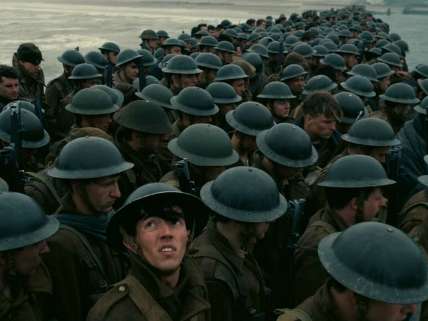Movie Review: Dunkirk
Christopher Nolan tries to make war great again.

There are a few familiar faces blinking through the tumult of Dunkirk: Tom Hardy, Mark Rylance, Kenneth Branagh, even teen-pop singer Harry Styles (who's very good in his first film role, as a young soldier). But their performances aren't the point. The movie's true star is its writer and director, Christopher Nolan, whose commitment to thunderous widescreen action and smashing IMAX cinematography is a wonder to behold.
In recounting the famous story of how more than 300,000 British and Allied troops were desperately evacuated off a French beach as the German army bore down on them in the spring of 1940, Nolan has produced a radical distillation of the traditional war movie. The picture is a loosely linked procession of incident and imagery; dialogue is minimal and there's virtually no exposition. (You might want to read up on the Dunkirk story before seeing the film.)
What we get instead is a tale roughly unfurled in three battle arenas: land, sea and sky. On the beach at Dunkerque, a town in the north of France, we see long lines of trapped soldiers awaiting salvation, their faces registering the numbed incomprehension of young men facing extinction before their lives have really gotten underway. Naval destroyers anchored offshore are ready to rescue these soldiers, but can't get close enough to do so because of the shallow waters; smaller boats would be required to ferry the men out to the ships. Back in England, less than 50 miles across the Channel, a flotilla of some 800 civilian craft are being requisitioned for this purpose, and Nolan puts us aboard one of these boats—a motor-yacht owned by a tweedy gentleman named Dawson (Rylance), who's already cutting through the waves on his way to Dunkirk accompanied two teenagers, one of them his son Peter (Tom Glynn-Carney). Meanwhile, high above, two RAF pilots (Tom Hardy and Jack Lowdon) are doing sensational pirouettes across the sky in pursuit of the Luftwaffe planes that are attacking the men on the beach below. (At one point we learn that the best way to determine when an outgoing tide has turned is when all the waterlogged corpses start washing back toward shore.)
The movie derives its unusual power in large part from its blunt style. There isn't much in the way of a formal story. Things just happen—we're not always certain exactly what or why, but then that, presumably, is how war would be. At the very beginning, German leaflets flutter down on puzzled soldiers like ominous autumn leaves ("You Are Surrounded"). As bombers howl overhead, a line of explosions marches up the beach practically into our lap. A soldier floating in an oil slick that's just been ignited by a crashing plane faces a choice of whether to die by drowning or burning. A shell-shocked soldier (Cillian Murphy) who's been marooned by a U-boat attack is picked up by Dawson's boat—and is horrified to learn that his rescuer isn't headed home to England, but back to Dunkirk.
Throughout all of this—throughout every single minute of all of this—Hans Zimmer's astonishingly apocalyptic score, with its bare-nerve string-wringing and drunken-giant synth-rumbles, sets a new standard for sonic overkill—and then overkills it. I mean this in a good way—without Zimmer's music, the picture would be substantially diminished.
What we have here is a new kind of war movie, made by a gifted and already much-admired director. I don't think it's Nolan's best film, because Nolan is also the guy who directed The Dark Knight, which is a much better film. The Dark Knight—like Memento and Inception, among other Nolan pictures—adheres to old-school touchstones like narrative and personality. Dunkirk has no interest in either of those things, which is okay—this is a movie that communicates the dislocations of war in a powerful new way, and will likely be studied and mumbled over by film-school scholars for years to come. How many non-scholars will be wanting to see it a second time we will soon discover.


Show Comments (106)